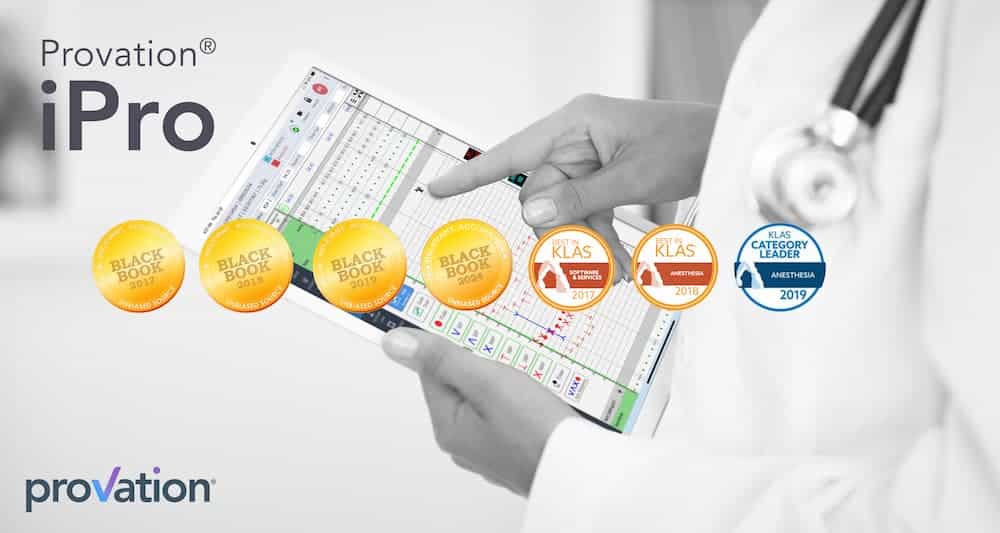Recent Blog Posts
Provation iPro AIMS Earns Top Marks in Black Book’s 2024 Ambulatory EHR User Survey
Staying ahead of the technology curve in healthcare is critical to success. In 2024, Provation® iPro Anesthesia Information Management System (AIMS) has done just that by securing the highest ranking in Anesthesia according to Black Book’s prestigious user survey. This recognition underscores Provation’s mission to empower providers to deliver quality healthcare for all with top […]
4 Benefits of Mobile Electronic Anesthesia Charting Software
In today’s fast-paced healthcare environment, maximizing efficiency and improving patient care is paramount. Anesthesia providers at a major health system in Florida recognized this and chose to take action by leveraging the electronic anesthesia charting software, Provation® iPro to automate their perioperative encounters on a mobile tablet. With this cutting-edge mobile Anesthesia Information Management System […]
Perioperative Software: What is it and how can it optimize my practice?
Perioperative software creates an electronic process to give physicians, nurses, and other care team members a way to automate the workflow and capture important patient health information (PHI) data before, during, and after surgery. With perioperative software, you can optimize your healthcare workflows — from preoperative patient scheduling to postoperative follow-up and everything in between. […]
Medical Charting Software Systems: 6 Ways to Eliminate Paper Documentation
Medical charting software systems vary significantly in functionality, usability, and cost Medical charting software can be as simple as a template creator or as complex as an electronic medical record (EMR) system, depending on the software provider and the healthcare facility’s needs. At Provation, we take patient medical charting seriously and develop all our software […]
Anesthesia Information Management Isn’t Fully Supported by an EMR. Here’s Why.
While Electronic Medical Records (EMR) have streamlined healthcare communication and documentation across the globe, there’s still a gap in the coverage they offer for anesthesia information management. Because the Anesthesia medical record the most document-intensive in healthcare, recording this information accurately is crucial to patient safety. Why anesthesia information management is still on paper While […]
Top 10 FAQs for Choosing the Best AIMS Anesthesia Software
Investing in automating your anesthesia information management can make a huge difference in patient safety and your bottom line. But, it’s important to make sure you’re choosing the best option for your facility. In order to decide which anesthesia information management system (AIMS) is the best option for your anesthesia staff, make sure you’re considering […]
Did MIPS Reporting 2022 Submission Season Require Expertise?
Merit-based Incentive Payment System (MIPS) has had admin teams across the county pulling their hair out over the laborious preparations required each submission season. Whether you have been extracting data from an Electronic Medical Record (EMR), merging your billing and quality data, or sifting through paper records, MIPS reporting 2022 was likely a huge time-suck […]
Future of Gastroenterology: Incorporating Artificial Intelligence (AI)
Artificial Intelligence (AI) in gastroenterology has the potential to democratize access to knowledge that has historically been held in the hands of specialists. For example, the expert scoring of endoscopic findings in inflammatory bowel disease can now be done automatically, and the results placed in the hands of primary care physicians, nurses, and even patients. […]
Lowering the Recommended Colorectal Cancer Screening Age
The U.S. Preventive Services Task Force (USPSTF) recommends lowering the age to start colorectal cancer (CRC) screenings from 50 to 45. USPSTF’s new recommendations are open for public comment until November 23, 2020.
Resuming Elective Procedures During COVID-19 (Podcast)
COVID-19 has reshaped the landscape of elective gastroenterology (GI) procedures. Mounting backlogs, reduced revenues and limited clinical staff have created open-ended uncertainty.
Developing a Proactive Recovery Plan for ASCs
ASC backlogs for critical elective procedures such as colonoscopies in the gastroenterology (GI) space are expanding daily, nationwide. Experts explain there are proactive recovery plans ASCs can create now for when elective procedures can continue.
Gastrointestinal (GI) Coronavirus Symptoms May Be Overlooked
Gastroenterologists may already be on the frontlines in the war against coronavirus. Becker’s ASC Review (GI & Endoscopy) recently warned of gastrointestinal (GI) coronavirus symptoms.
Rural Hospital Closures Hit “Crisis” Levels
120 rural hospitals nationwide closed from 2010 through January 1, 2020. The CCRH called this situation the “the rural hospital closure crisis.” Here are key reasons why facilities that provide life-saving healthcare in rural and remote parts of the country are shutting down.
Does Physician Dictation and Transcription Save Time?
Many physicians believe dictation and transcription is the quickest way to document procedures and get back to patient care. Which is true, until it's not.
Cloud-Based Software: Best Practices for ASC Implementation
Cloud-based software is revolutionizing clinical documentation. Discover best practices for implementing a new SaaS solution at your ASC.
CMS 2020 Final Rules for Quality Reporting
Centers for Medicare and Medicaid Services (CMS) released changes in quality reporting for 2020. See MIPS, ASCQR and HOQRP removals and additions.
Adenoma Detection Rate (ADR) Removed from MIPS
Many gastroenterology (GI) physicians report to MIPS for quality reporting. Read why CMS (Centers for Medicare and Medicaid Services) dropped the measure.
Ways to Ensure Clinical Documentation Improvement (CDI) Success
Hospitals and ASCs across the nation are implementing clinical documentation improvement programs. Discover six key steps to achieving a successful CDI program.
Why Nursing Documentation Software Should Be Intuitive, Comprehensive and Precise
Comprehensive nursing documentation software should lie at the top of the priority list for all hospitals and ASCs.
Attributing Correct ICD-10 and CPT® Codes
Precise medical billing and coding is vital because the success of healthcare businesses relies on the accuracy of procedure codes.
Maximizing GI Procedure Success with the GIQuIC Registry
Facilities that report to the GIQuIC registry can monitor and report on GI procedure quality benchmarks, as well as measure successful outcomes against competitors.
Calculating an Adenoma Detection Rate (ADR) Properly
Automated calculation and reporting exist to track and improve ADRs across facilities, and to keep physicians engaged with the success of their procedures.
